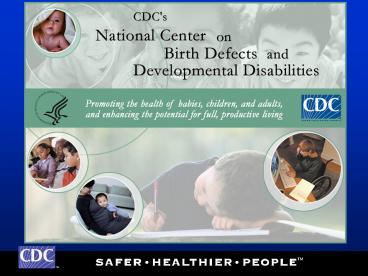Disability Activities at CDC PowerPoint PPT Presentation
1 / 29
Title: Disability Activities at CDC
1
(No Transcript)
2
Disability Activities at CDC
- Ed Brann, MD, MPH, Director,
- Division of Human Development and Disability
3
Todays Presentation
- Explain CDCs Role in the Primary Prevention of
Disabilities - Explain CDCs approach to ensuring people with
disabilities have the same access to public
health as people without disabilities.
4
Primary Prevention of Disability Activities
- HIV
- Injury (Intentional and Unintentional)
- Workplace Injury
- Diabetes (weight loss/diet)
- Arthritis (physical activity)
- Cancer Screening
5
Primary Prevention of Disability Activities
- Reproductive Health (low birth weight and
perinatal infections) - Birth Defects
- Neural tube defects
- Etiology of birth defects and developmental
disabilities - Fetal Alcohol Syndrome
- Kernicterus
6
Health Promotion Activitiesfor People With
Disabilities
- Spinal cord injury (includes decubiti prevention)
- Traumatic brain injury
- Diabetes
- Arthritis
- Obesity
- Aging
7
Health Promotion Activitiesfor People With
Disabilities
- Early Hearing Detection and Intervention
- Newborn Screening
- Attention Deficit Hyperactivity Disorder
- Down Syndrome
- Fetal Alcohol Syndrome
8
Health Promotion Activitiesfor People With
Disabilities
- Mental Retardation
- Muscular Dystrophy
- Autism
- Disability and Health
9
CDCs Disability and Health Program
- Approximately 50 million people in the U.S. have
a disability - Disability refers to limitations in carrying out
socially defined tasks or roles that are related
to impairments in physical or cognitive structure
or function caused by one or more health
conditions
10
CDCs Disability and Health Program
- If a person with a disability maintains good
health, he or she will be more likely to
participate in socially defined roles such as
working and going to school
11
CDCs Disability and Health Program
- Program Focus
- Examine the health of people with disabilities
and then establish useful interventions and
health promotion programs - Promote accessible public health programs for
people with disabilities
12
Disability and Health ProgramGuiding Principles
- Disability does not equate to poor health
- People with disabilities deserve the same access
to health as people without disabilities - Many health conditions that diminish the quality
of life for people with disabilities can be
prevented - Improvements in or maintenance of health promotes
better functioning and participation in society
13
Disability and Health ProgramGuiding Principles
- Interaction between the environment and the
person functioning. The effects of disability
can be mediated by supportive environments and
assistive technology. - Quality of life and functioning are diminished by
preventable health conditions secondary to the
persons disability
14
Two Major Foci
- State capacity building
- Research
15
Steps in the Process
- Health surveillance in people with disabilities
16
Data Collection on Disability
- National Health Interview Survey (NHIS)
- National Health and Nutrition Examination Survey
(NHANES) - State and Local Area Integrated Telephone Survey
(SLAITS) national survey of children with special
health care needs - Behavioral Risk Factor Surveillance System
(BRFSS)
17
Source Behavioral Risk Factor Surveillance
System, NCCDPHP, 2001
18
Steps in the Process
- Health surveillance in people with disabilities
- Epidemiologic studies of disability and comorbid
conditions
19
Source Behavioral Risk Factor Surveillance
System, NCCDPHP, 2001
20
Steps in the Process
- Health surveillance in people with disabilities
- Epidemiologic studies of disability and comorbid
conditions - Intervention developmental and testing evaluation
21
Health interventions
- Eight-week workshop
- that emphasizes
- Goal setting and clarification
- Health awareness
- Connection between health and functioning
- Health behaviors
22
Health Interventions
- Savings of 250-1,000 per participant per year,
above program costs
23
Health Intervention Evaluation
- Effectiveness of health communication materials
in NC, NY and NM - Establish guidelines for future materials
24
Steps in the ProcessHealth Services
DeliveryEliminating Disparity in Screening
Collaboration with Breast and Cervical Cancer
Early Detection Program in NCCDPHP
Support to state Disability Health programs to
acquire adaptive screening tables
25
Barriers to Breast Cancer Screening
- Difficulty with positioning
- Inaccessible facilities and equipment
- Provider attitudes
26
Steps in the Process
- Workforce Development
27
Other Activities
- Workforce development curriculum
- Cost studies
- QoL studies
- Improvement measurement (NCHS, NCBDDD, ICF)
- Academic Excellence
- Focus of health and public health community
- State and local emphasis
- Partners and advisory groups
- International collaborations
28
Wrap Up
- Public health approach to disability
- People with disabilities have many of the same
health concerns as people without disabilities - CDC is working to identify and eliminate barriers
to good health for people with disabilities
29
- More information about CDCs disability
activities is available at ww.cdc.gov/ncbddd
Ed Brann, MD, MPH, Director, Division of Human
Development and Disability ebrann_at_cdc.gov

